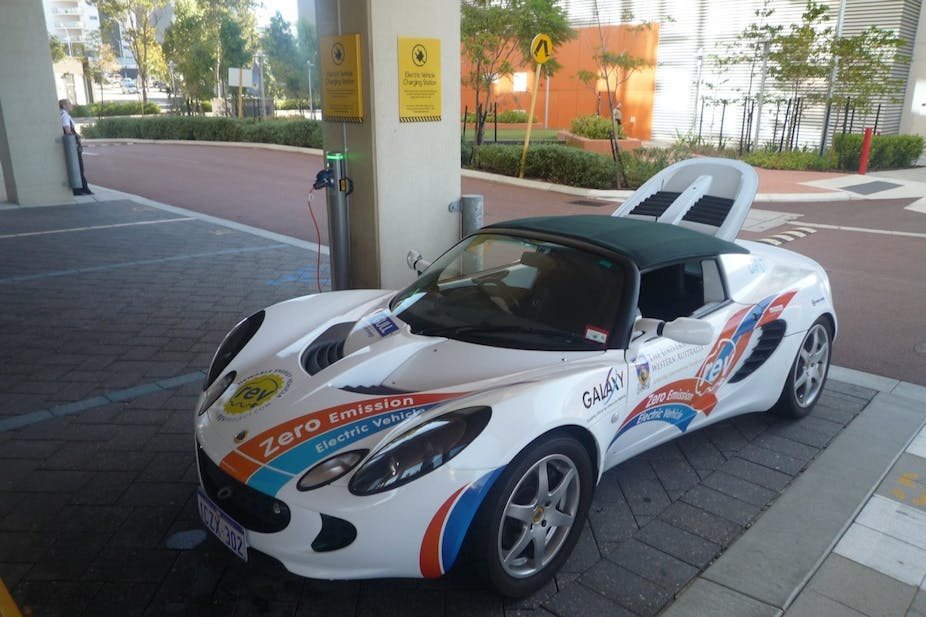With global warming, carbon trading and record-high petrol prices in the news, not to mention the ever-looming spectre of peak oil, we need to find an environmentally sustainable and socially acceptable solution for transport.
While vehicles powered by hydrogen fuel-cells have been the favoured solution for the last decade, most car makers now agree that electric cars are the way forward.
At the University of Western Australia’s Renewable Energy Vehicle Project, we’ve been conducting a range of projects that will hopefully take us further down that road.
Existing technology
The first electric cars are already on our roads (hybrids such as the Toyota Prius, for example), and almost all major car manufacturers in Europe, North America and Asia have announced battery-electric cars for the year 2013.
Given it usually takes a year for new cars to make it to Australia, we should have a fairly good selection to choose from by 2014.
Electric cars are by no means a new concept – they’ve been around, on and off, for more than 100 years, indeed since the very first cars were built.
But it is only now with the improved Lithium-Ion battery technology, enabled by the market power of mobile phones and laptop computers, that electric cars can be built as a viable alternative to petrol and diesel cars.
Electric cars have a large number of advantages over the existing technology:
- They are emission-free if charged from renewable energy sources.
- They create very little driving noise at low speeds.
- They require very little service requirements as compared to a petrol/diesel car.
- They have much cheaper running costs compared to a petrol/diesel car.
- They are not dependent on imported oil.
- There is no initial infrastructure required (electric vehicle owners can recharge their cars at home).
But they do have one big disadvantage: a limited driving range (typically 120-150km) in combination with a relatively long recharging time (two to three hours on a level-2 charging station).
This issue clearly needs to be addressed in order to increase the uptake of electric cars.
The family runaround
One approach is to look at only a fraction of the market: many families have two cars, with one being a smaller city commuter car, which could be an electric car with a limited range.
The other approach is to add (optional) “range-extenders” to electric cars, which are small petrol or diesel generators, which will kick in after the initial pure battery-electric range (of 150km) has been used up.
In this way, the car can drive a much longer distance, (but will lose its environmental friendliness when going over the electric-only range).
Testing the waters
Western Australia is the first Australian state to conduct an Electric Vehicle Trial – actually two trials, one on the vehicle side and one on the recharging side, both launched in early 2010. (Electric vehicle trials have been happening around the world for a number of years; a 2009 government-funded trial in the UK, for example).
The trials are an extension of the University of Western Australia’s Renewable Energy Vehicle Project, which so far has converted a Hyundai Getz (a good example of a sensible commuter solution) and a Lotus Elise (a good example of an exclusive sport performance car) to road-licensed battery-electric cars.
In consultation with Perth-based company EV Works we are also converting eleven Ford Focuses, five of which are already on the road.
Road tests have established the range of these electric Ford Focus’s at more than 130km, which will be sufficient for use as vehicles for the the average Australian daily commute of 30km.
Charging issues
Our most recent trial looks especially at charging station issues, monitoring charging activities and using day-time dependent tariff structures as an incentive to shift charging times away from peak energy usage times (in the evenings or before the morning rush, for example).
We decided to use Level-2 fast-charging stations as the lowest entry level for EV charging infrastructure, which is either three-phase (415V) or single-phase (240V, 32A) power.
So far, one charging station has been installed at the RAC in West Perth, with ten more only weeks away from deployment.
In the meantime, other Australian states have announced forthcoming EV trials, with significant funding, which is great.
We hope results from the various trials can be shared and that Australian power generators and network operators will start to take an active role in these developments.
We are at the brink of the largest revolution in automotive history with far-reaching effects on the power industry, so complacency, to borrow a term, is a non-starter.
Would you swap your current vehicle for an electric car? Post your replies below.

